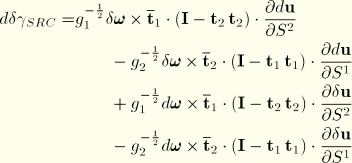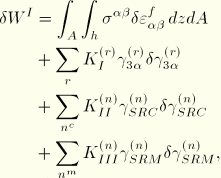
Product: ABAQUS/Standard
This section discusses the formulation of the small-strain shear flexible elements in ABAQUS/Standard, which are quadrilaterals (S4R5, S8R5, S9R5, and S8R), except for the 6-node triangle STRI65. The essential idea of these elements is that the position of a point in the shell reference surface—![]() —and the components of a vector
—and the components of a vector ![]() —which is approximately normal to the reference surface—are interpolated independently. The kinematics of the shell theory then consist of measuring membrane strain on the reference surface from the derivatives of
—which is approximately normal to the reference surface—are interpolated independently. The kinematics of the shell theory then consist of measuring membrane strain on the reference surface from the derivatives of ![]() with respect to position on the surface and bending strain from the derivatives of
with respect to position on the surface and bending strain from the derivatives of ![]() ; the strain measures that are used for this purpose are approximations to Koiter-Sanders theory strains (Budiansky and Sanders, 1963). The transverse shear strains are measured as the changes in the projections of
; the strain measures that are used for this purpose are approximations to Koiter-Sanders theory strains (Budiansky and Sanders, 1963). The transverse shear strains are measured as the changes in the projections of ![]() onto tangents to the shell's reference surface. For these element types the strain measures are suitable for large rotations but small strains, and the change in the shell's thickness caused by deformation is neglected.
onto tangents to the shell's reference surface. For these element types the strain measures are suitable for large rotations but small strains, and the change in the shell's thickness caused by deformation is neglected.

A typical piece of shell surface is shown in Figure 3.6.3–1.
Let (
In the rest of this section Greek indices will be used to indicate values associated with the (two-dimensional) reference surface and so will sum over the range 1, 2 under the summation convention.
First, we establish convenient directions for stress and strain output. These will be local material directions, indistinguishable (to the order of approximation) from corotational directions, since we assume strains are small. The standard convention used throughout ABAQUS for such local directions on a surface is as follows.
It is most convenient to choose orthogonal directions. Define
![]()
![]()
![]()
Let
![]()
![]()
![]()
Stress and strain components are formed in the (![]() ,
, ![]() ) directions.
) directions.

The following surface measures are defined. The metric of the deformed surface is
![]()
![]()
The corresponding measures associated with the original reference surface are the metric
![]()
![]()

The nodal variables for shell elements are the displacements of the shell's reference surface, ![]() , and the normal direction,
, and the normal direction, ![]() . Since
. Since ![]() is defined to be a unit vector, only two independent values are needed to define
is defined to be a unit vector, only two independent values are needed to define ![]() , so that this type of shell element needs only five degrees of freedom per node. In ABAQUS this issue is addressed in two ways. At nodes in a smooth shell surface in those elements that naturally have five degrees of freedom per node, ABAQUS stores the values of the projections of the change in
, so that this type of shell element needs only five degrees of freedom per node. In ABAQUS this issue is addressed in two ways. At nodes in a smooth shell surface in those elements that naturally have five degrees of freedom per node, ABAQUS stores the values of the projections of the change in ![]() projected onto two orthogonal directions in the shell surface at the start of the increment to define
projected onto two orthogonal directions in the shell surface at the start of the increment to define ![]() . Otherwise, ABAQUS stores the usual rotation triplet,
. Otherwise, ABAQUS stores the usual rotation triplet, ![]() , at the node. This latter method leaves a redundant degree of freedom if the node is on a smooth surface. A small stiffness is introduced locally at the node to constrain this extra degree of freedom to a measure of the same rotation of the shell's reference surface.
, at the node. This latter method leaves a redundant degree of freedom if the node is on a smooth surface. A small stiffness is introduced locally at the node to constrain this extra degree of freedom to a measure of the same rotation of the shell's reference surface.

The same bipolynomial interpolation functions are used for all components of ![]() ,
, ![]() ,
, ![]() , and
, and ![]() . The shear flexible shell elements in the library use bilinear interpolation (four nodes), fully biquadratic interpolation (nine nodes), and “serendipity” quadratics (eight nodes).
. The shear flexible shell elements in the library use bilinear interpolation (four nodes), fully biquadratic interpolation (nine nodes), and “serendipity” quadratics (eight nodes).

The reference surface membrane strains are
![]()
The curvature change is
![]()
The transverse shears are
![]()

In addition to these strains, when six degrees of freedom are used at the nodes of the elements, the extra rotation degree of freedom is constrained with a penalty, as follows.
When such a node is the corner node of an element, define ![]() ,
, ![]() ,
, ![]() ,
, ![]() , and
, and ![]() in the element as above. Notice that these will be different in each element at the node, since the interpolated surface is not generally continuous. Then the strain to be penalized is defined as
in the element as above. Notice that these will be different in each element at the node, since the interpolated surface is not generally continuous. Then the strain to be penalized is defined as
![]()
![]()

At each midside node in the original configuration, define ![]() as the average surface normal for the elements of this surface branch at the nodes (there will be at most two such elements) and
as the average surface normal for the elements of this surface branch at the nodes (there will be at most two such elements) and ![]() as the tangent to the edge. Then define
as the tangent to the edge. Then define
![]()
![]()
The strain to be penalized at these midside nodes is then defined as
![]()


The transverse shear strains are calculated at a set of reduced integration points and have the following stiffness associated with them:
![]()
When rotation constraints are required at nodes that use six degrees of freedom, the penalty used is
![]()
This is the same as the transverse shear constraint, except that ![]() is here an area “assigned” to the node and the factor
is here an area “assigned” to the node and the factor ![]() is introduced. This (small) factor has been chosen based on numerical experiments, to be large enough to avoid singularities yet small enough to avoid adding significantly to the stiffness of the model.
is introduced. This (small) factor has been chosen based on numerical experiments, to be large enough to avoid singularities yet small enough to avoid adding significantly to the stiffness of the model.
These strain measures, with the interpolation specified above, give zero strain for any general rigid body motion
![]()

In forming the initial stress matrix we approximate by neglecting ![]() ,
, ![]() , etc, to simplify the expressions and reduce the cost of forming the matrix. Numerical experiments have suggested that, at least for the problems tested, this does not significantly affect the convergence rate. With this approximation,
, etc, to simplify the expressions and reduce the cost of forming the matrix. Numerical experiments have suggested that, at least for the problems tested, this does not significantly affect the convergence rate. With this approximation,
![]()





For these shell elements the internal virtual work rate is assumed to be

![]()
![]()
The thickness direction integrations are performed numerically in ABAQUS. The integration scheme is a Simpson's rule, of user-chosen order. The shell can also be considered layered, with different properties at each layer and a different integration scheme assigned (by the user) to each layer.

The load stiffness associated with pressure loading is often important in shells, especially in eigenvalue buckling estimates on elastic shells. In ABAQUS/Standard the pressure load stiffness is implemented as a symmetric form, thus assuming that the pressure magnitude is constant over the surface and neglecting free edge effects. See Hibbitt (1979) and Mang (1980) for details.
The load stiffness is obtained in such a form as follows. The external virtual work associated with pressure is
![]()
![]()
Thus,
![]()
The change in this term caused by change of displacement of the shell (the “load stiffness”) is
![]()

This is the pressure load stiffness provided in ABAQUS.